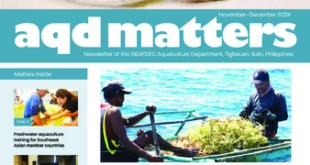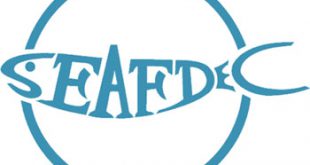 Technology Description
Technology Description
Grouper is a high-value species like tiger shrimp, and with prudent pond management, it is easier to culture without the attendant disease problems with prudent pond management. Shrimp farmers seeking alternative crops have found one in grouper.
Preparing the ponds for grouper is similar to milkfish and shrimp pond preparation. In addition, grouper fry or “tiny” need to be nursed first and must be regularly sorted and size-graded. Rectangular netcages supported by bamboo poles and installed inside the pond can serve as nursery. A hover-type lamp can attract live food for the grouper fry. Nursery takes about a month.
At the same time that grouper fry is stocked in the nursery, adult tilapia are released into grouper grow-out ponds so these, too, have a month to reproduce. Tilapia fingerlings will then serve as prey to grouper fingerlings from the nursery. In addition to tilapia, chopped trash fish and/or a formulated feed for carnivorous species may be given to grouper.
Regular monitoring and water changes are part of the pond routine for taking care of the stock. Grouper takes 5-7 months to attain a market-size of 400-800 g. If marketed live, fish farmers need to install temporary nets and tanks where grouper can be held while awaiting buyers and the completion of live packing for transport.
| Technology profile: | |
| (1) Prepare the ponds like you would for milkfish. Stock adult tilapia at 5,000 to 10,000 per ha; its fingerlings will later serve as food for grouper.
(2) Install nursery cages if 2-3 cm fry are the only ones available for stocking the grow-out ponds. Bigger-sized fish (5-10 cm) can be stocked directly. Rectangular netcages can be used, and these are kept upright with bamboo or wooden support. Cage size varies, from 4 x 2 x 1.5 m to 8 x 4 x 1.5 m. Net mesh size is 0.5 cm. Stocking density is 60 fry per m3 (3) Install 50-watt incandescent, hover-type lamp in every cage, about a foot above the waterline, to attract mysids, copepods, and other young fishes and crustaceans at night. These are live food for the grouper fry, although they may also be given finely-chopped trashfish and/or mysid shrimps or “alamang.” (4) Sort and grade the fry weekly to minimize competition for space and food and prevent cannibalism. Make sure there are extra netcages for the sorted stock. (5) Transfer fry to grow-out pond when they are bigger, about 5-10 cm, usually after 30-45 days in the nursery. Stock at 5,000 per ha. (6) Check if there are already tilapia fingerlings in the pond. There may be a need to feed more, so give chopped trash fish at the rate of 5% of grouper biomass per day. Give half of the feed in the morning, the rest in the afternoon. Place half in a feeding tray for monitoring purposes, and broadcast the rest. If using formulated feeds, take the advice on the feed label. Overfeeding leads to rapid deterioration of water quality. (7) Do the routine pond activities: monitor water parameters (dissolved oxygen, salinity, temperature, depth), change water as the tide dictates, take weight-length measurements of some of the stock so that feeding can be adjusted. (8) Selectively harvest in 5-7 months when some of the grouper are already market-sized (400 to 800 g). Harvest by using modified liftnets placed at the pond bottom. Provide shelters like sawed-off bamboos or PVC pipes in the middle of the net. Carefully lift the net in early morning when most of the grouper hide themselves there. Take only the biggest fishes and transfer to a pre-installed net that is 4 x 8 x 1.5 m with 1-2 cm mesh size. Stock the harvested grouper at 20 per m3 (9) To pack live grouper for transport, place 3-5 fish inside double-sheeted plastic bags with enough water to cover the nostrils of the grouper. Close the bags and pack in standard styrofoam boxes. Place crushed ice on top of the plastic bags to keep fish cool. |
|
References:
APEC / SEAFDEC Aquaculture Department. 2001. Husbandry and health management of grouper. Asia-Pacific Economic Cooperation, Singapore (APEC Publication No. 201-FS-03.1) and SEAFDEC Aquaculture Dept, Tigbauan, Iloilo. 94 p (In English, Filipino, Bahasa, Thai, Mandarin)
Baliao DD, de los Santos MA, Rodriguez EM, Ticar EM. 1998. Grouper culture in brackishwater ponds. Aquaculture Extension Manual No. 24, SEAFDEC Aquaculture Department, Tigbauan, Iloilo. 18 p
Bombeo-Tuburan I, Coniza EB, Rodriguez EM, Agbayani RF. 2001. Culture and economics of wild grouper (Epinephelus coioides) using three feed types in ponds. Aquaculture 201:229-240
Bombeo-Tuburan I, Coniza EB, Rodriguez E. 2002. Preliminary report on nursery and grow out culture of hatchery-bred grouper (Epinephelus coioides Hamilton) in ponds. Aquaculture Research 33:379-381
Duray MN. 1994. Daily rates of ingestion on rotifers and Artemia nauplii by laboratory-reared grouper larvae of Epinephelus suillus. Philippine Scientist 31:32-41
Duray MN, Estudillo CB, Alpasan LG. 1997. Larval rearing of the grouper Epinephelus suillus under laboratory conditions. Aquaculture 150:63-76
Estudillo CB, Duray MN. 2003. Transport of hatchery reared and wild grouper larvae, Epinephelus sp. Aquaculture 219:279-290
Grouper culture. 1999. A 3-fold flyer downloadable from the SEAFDEC/AQD website www.seafdec.org.ph/publications_downloadable.html
Kohno H, Triño A, Gerochi D, Duray M. 1989. Effects of feeding frequency and amount of feeding on the growth of the grouper, Epinephelus malabaricus. The Philippine Journal of Science 118:89-100
Millamena OM, Golez NV. 2001. Evaluation of processed meat solubles as replacement for fish meal in diet for juvenile grouper Epinephelus coioides (Hamilton). Aquaculture Research 32 (Supplement 1): 281-287
Millamena OM. 2002. Replacement of fish meal by animal by-product meals in a practical diet for grow-out culture of grouper Epinephelus coioides. Aquaculture 204:75-84
Nagasawa K, Cruz-Lacierda ER, eds. 2004. Diseases of cultured groupers. SEAFDEC Aquaculture Department, Tigbauan, Iloilo. 81 p. (This is also available on CD format)
Pomeroy RS, Agbayani R, Duray M, Toledo J, Quinitio G. 2004. The financial feasibility of small-scale grouper aquaculture in the Philippines. Aquaculture Economics and Management 8:61-84
Tendencia EA, Fermin AC, de la Peña MR, Choresca CH Jr. 2006. Effect of Epinephelus coioides, Chanos chanos, and GIFT tilapia in polyculture with Penaeus monodon on the growth of the luminous bacteria. Aquaculture 253:48-56
Toledo JD, Nagai A, Javellana D. 1993. Successive spawning of grouper, Epinephelus suillus (Valenciennes), in a tank and a floating net cage. Aquaculture 115:361-367
Toledo JD, Golez MS, Doi M, Ohno A. 1999. Use of copepod nauplii during early feeding stage of grouper Epinephelus coioides. Fisheries Science 65:390-397
Toledo JD, Naret E, Nakagawa H. 2005. Comparison of fatty acid profile between cultured and wild-caught grouper, Epinephelus coioides. Aquaculture Science 53:127-134
 SEAFDEC/AQD Southeast Asian Fisheries Development Center | Aquaculture Department
SEAFDEC/AQD Southeast Asian Fisheries Development Center | Aquaculture Department

